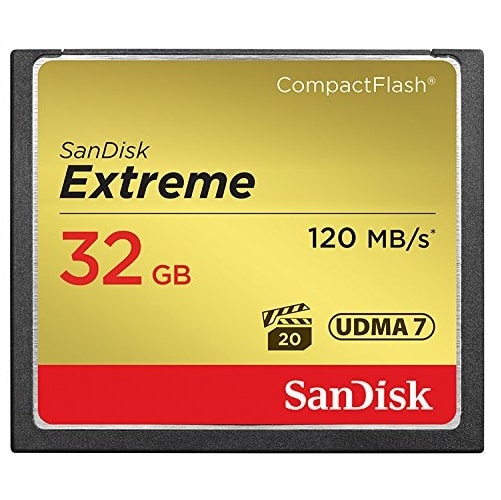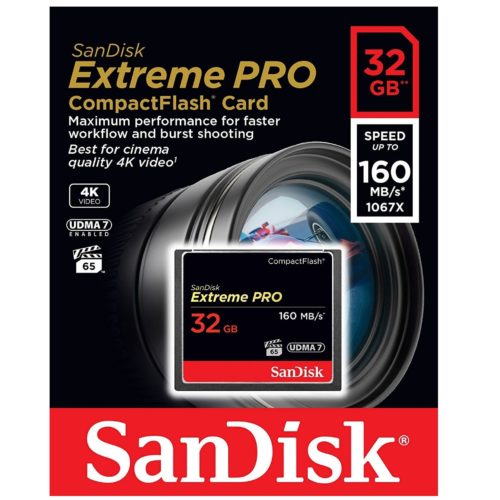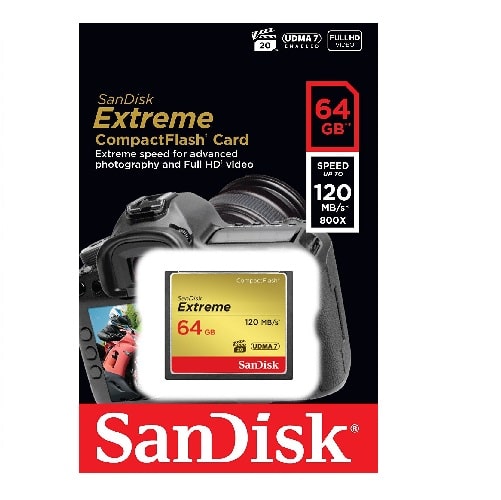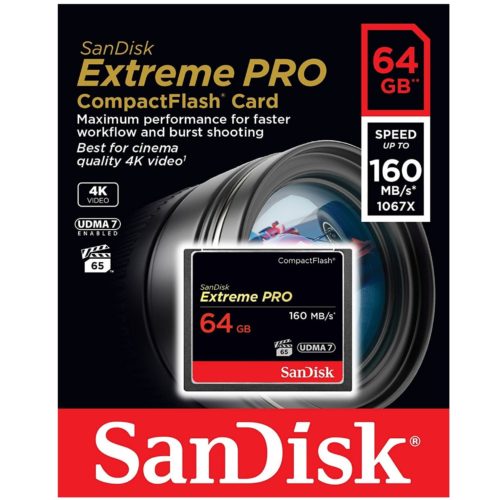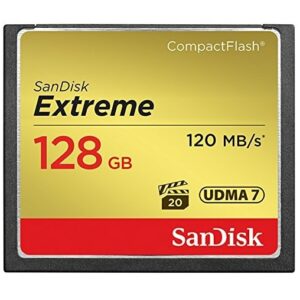CF Cards | CompactFlash Cards
Showing all 5 resultsSorted by price: low to high
-
CF Cards | CompactFlash Cards
32GB CF Extreme Sandisk CompactFlash Memory Card (SDCFXSB-032G-G46)
The 32GB CF Extreme SanDisk CompactFlash card is a great choice for photographers and professionals looking for higher transfer speeds and higher quality images.
Read speeds up to 120MB/s and write speeds up to 85MB/s.
Specifications
- Model Number: SDCFXSB-032G-G46
- Video Performance Guarantee (VPG): 20
- UDMA: 7
- Read Speed: Max 120MB/s
- Write Speed: Max 85MB/s
- Operating Temperature: -13° – 185° F (-25°C – 85° C)
Writable label for easy identification and organization
Jewel Case to protect your card for storing and archiving
Extreme durability, sealed with RTV silicone for added protection against shock & vibrationEstimated Number of Photos & Videos
JPG Photos: 8,620 photos
RAW Photos: 595 photos
HD Video: 425 minutes
4k Video: 85 minutes**This product comes in original retail packaging ready for resale. EBS return policy linked here.
Model # SDCFXSB-032G-G46
(2 reviews) -
CF Cards | CompactFlash Cards
32GB CF Extreme Pro Sandisk CompactFlash Memory Card (SDCFXPS-032G-X46)
The 32GB CF Extreme Pro SanDisk CompactFlash card is a great choice for photographers and professionals looking for higher transfer speeds and higher quality images.
Read speeds up to 160MB/s and write speeds up to 150MB/s.
Specifications
- Model Number: SDCFXPS-32G-X46
- Video Performance Guarantee (VPG): 65
- UDMA: 7
- Read Speed: Max 160MB/s
- Write Speed: Max 150MB/s
- Operating Temperature: -13° – 185° F (-25°C – 85° C)
Writable label for easy identification and organization
Jewel Case to protect your card for storing and archiving
Extreme durability, sealed with RTV silicone for added protection against shock & vibrationEstimated Number of Photos & Videos
JPG Photos: 8,620 photos
RAW Photos: 595 photos
HD Video: 425 minutes
4k Video: 85 minutes**This product comes in original retail packaging ready for resale. EBS return policy linked here.
Model # SDCFXPS-032G-X46
(0 reviews) -
CF Cards | CompactFlash Cards
64GB CF Extreme Sandisk CompactFlash Memory Card (SDCFXSB-064G-A46)
The 64GB CF Extreme SanDisk CompactFlash card is a great choice for photographers and professionals looking for higher transfer speeds and higher quality images.
Read speeds up to 120MB/s and write speeds up to 85MB/s.
Specifications
- Model Number: SDCFXSB-064G-A46
- Video Performance Guarantee (VPG): 20
- UDMA: 7
- Read Speed: Max 120MB/s
- Write Speed: Max 85MB/s
- Operating Temperature: -13° – 185° F (-25°C – 85° C)
Writable label for easy identification and organization
Jewel Case to protect your card for storing and archiving
Extreme durability, sealed with RTV silicone for added protection against shock & vibrationEstimated Number of Photos & Videos
JPG Photos: 17,245 photos
RAW Photos: 1,190 photos
HD Video: 850 minutes
4k Video: 170 minutes**This product comes in original retail packaging ready for resale. EBS return policy linked here.
Model # SDCFXSB-064G-A46 or SDCFXSB-064G-G46
(0 reviews) -
CF Cards | CompactFlash Cards
64GB CF Extreme Pro Sandisk CompactFlash Memory Card (SDCFXPS-064G-X46)
The 64GB CF Extreme Pro SanDisk CompactFlash card is a great choice for photographers and professionals looking for higher transfer speeds and higher quality images.
Read speeds up to 160MB/s and write speeds up to 150MB/s.
Specifications
- Model Number: SDCFXPS-64G-X46
- Video Performance Guarantee (VPG): 65
- UDMA: 7
- Read Speed: Max 160MB/s
- Write Speed: Max 150MB/s
- Operating Temperature: -13° – 185° F (-25°C – 85° C)
Writable label for easy identification and organization
Jewel Case to protect your card for storing and archiving
Extreme durability, sealed with RTV silicone for added protection against shock & vibrationEstimated Number of Photos & Videos
JPG Photos: 17,245 photos
RAW Photos: 1,190 photos
HD Video: 850 minutes
4k Video: 170 minutes**This product comes in original retail packaging ready for resale. EBS return policy linked here.
Model # SDCFXPS-064G-X46
(0 reviews) -
CF Cards | CompactFlash Cards
128GB CF Extreme Sandisk CompactFlash Memory Card (SDCFXSB-128G-G46)
The 128GB CF Extreme SanDisk CompactFlash card is a great choice for photographers and professionals looking for higher transfer speeds and higher quality images.
Read speeds up to 120MB/s and write speeds up to 85MB/s.
Specifications
- Model Number: SDCFXSB-128G-G46
- Video Performance Guarantee (VPG): 20
- UDMA: 7
- Read Speed: Max 120MB/s
- Write Speed: Max 85MB/s
- Operating Temperature: -13° – 185° F (-25°C – 85° C)
Writable label for easy identification and organization
Jewel Case to protect your card for storing and archiving
Extreme durability, sealed with RTV silicone for added protection against shock & vibrationEstimated Number of Photos & Videos
JPG Photos: 34,490 photos
RAW Photos: 2,380 photos
HD Video: 1,705 minutes
4k Video: 340 minutes**This product comes in original retail packaging ready for resale. EBS return policy linked here.
Model # SDCFXSB-128G-G46
(0 reviews)
CF cards are memory cards are widely used in portable electronic devices, especially digital cameras by recreational and professional photographers and moviemakers.
CF cards have stood the test of time, first hitting the market in 1994. Just as with SD cards and micro SD cards cards, they’re capable of storing large quantities of data. Photographers needing to store thousands of high-quality images turn to large CF cards to handle the job.
When getting ready to make a purchasing decision about CF cards, consider your use cases. It might just be advantageous for you to buy more storage capacity than you need now to give your memory cards greater use capacities down the road.
Unlike with SD cards for many users, speed is especially critical when it comes to CF cards. Ensure the card class and read and write speeds are equipped to handle the demands you require of your camera or camcorder.
What Is a CF Card?
A CF card, short for CompactFlash card (also styled as Compact Flash card), is a flash-based mass-storage device. Weighing a half-ounce and, at 1.7 inches x 1.4 inches x 0.13 inches, roughly the size of a large postage stamp, CF cards are prized for their portability, durability and speed.
With speed, CF cards deliver ultrafast read and write speeds demanded by users of high-end digital equipment. CompactFlash cards are ideal particularly for digital photography and video recording. High-end still and video photography equipment captures very large digital files that must be written to temporary memory before being transferred to permanent storage.
Common CF Card Sizes
Common CF cards sizes range from 2 GB to 256 GB, with Everything But Stromboli carrying the popular sizes of 32 GB, 64 GB and 128 GB. Older cards with smaller storage capacities are available but don’t hold much data.
Depending on your usage—be it casual or professional photography or video—your storage needs will vary. Your goal is to find a large enough CF card at a price that fits your budget.
CF Card Specs: What Does Each CF Card Terminology Indicate
Just as with researching SD cards and micro SD cards, when exploring CompactFlash cards, you’ll see lots of CF card specs. The Everything But Stromboli team produced the following guide so you can identify the product(s) you need.
- CF Card: CompactFlash card, also written as Compact Flash card, that is inserted into devices such as digital cameras and camcorders for file storage.
- Class or series: The class is the rated classification for the card’s write speed and describes how fast information can be uploaded and written to the card. The class number appears in the bottom-left corner of card labels.
- Read speed: The speed at which data is read from the card. This number is displayed in the middle right of card labels.
- Write speed: The speed at which files are written to the card. This number is displayed in the bottom right of card labels.
CF Cards Explained
Write speeds on CF cards have increased significantly over the years. Average CF write speeds today range up to more than 150 MB per second. High-write speed for CF cards is about 150 MB per second and upward of 440 MB per second for extreme professional cards. These high-write speeds are needed to handle fast-capture bursts for large digital photos and manage extended HD and even 4K video recording.
Durability in CompactFlash cards is another key element to consider. Modern devices demand that memory cards hold up against regular extended and repeated use, so major manufacturers have produced high-quality CF cards that last for years. Photographers and videographers especially need to be able to reach into their camera bags and grab a CF card without worrying whether it’s going to capture or record what they intend.
Reliability may be almost as important as durability. CF cards often hold precious personal memories such as photos of children at all stages of life or moments in time that fuel a professional photographer’s livelihood. Be sure to check the reliability of CF cards such as how well they are constructed and ratings for whether they fail after extended use. Everything But Stromboli carries CompactFlash cards of exceptional build quality, promoting reliability, from manufacturers that continue to enhance their CF card success year after year.
The thirst for more storage and faster write speeds among CF card users will never end. The good news is that the price for extended storage and higher write speeds has dropped to a cost-conscious level for all users.
Affordable pricing provides CF card users a distinct advantage in a final key element: security. The more cards you use to spread out your data storage, the less likely you’ll lose it all at once. For years, photographers and videographers have been shooting on many cards for a single, momentous event. If one card is lost, damaged or fails, most of the event memories will still be preserved. Recording any important event on a single storage device is not a secure practice.
Bulk CF Cards
When you purchase bulk CF cards, you’ll pay less per unit, saving you a considerable amount of money with large-quantity orders.
Everything But Stromboli simplifies the process of purchasing wholesale CF cards. Save with wholesale discounts on 32 GB CF cards and 64 GB CF cards. You can order quantities of 10, 50, 100, 500 or 1,000 CF cards.
Contact us now to take advantage of our affordable pricing so you can be prepared at your next photo shoot or event.
How to Format CF Card
CF cards may be formatted directly on cameras or camcorders into which they’re inserted. Keep in mind that, when you format a CF card, all files will be deleted.
With most cameras and camcorders, the format function is accessible via the menu option and takes only seconds to complete.
How to Format CF Card on Windows 10
To format a CF card on Windows 10, open Windows Explorer and find the drive letter for your card. Right-click on this drive letter and click “format” when the menu pops up.
On the Format screen, the file system defaults to FAT32. This is an older format and acceptable for use with smaller cards. For cards with at least 64 GB of storage, choose exFAT. You now can input a name for the formatted drive by keying it into the volume label. Click on the “start” button to format your card
How to Format CF Card on a Mac
To format a CompactFlash card on a Mac, launch the Disk Utility program inside the Applications folder. Locate the card along the left column and click the “erase” button at the top of the screen. Choose the format you desire and press the “erase” button.


